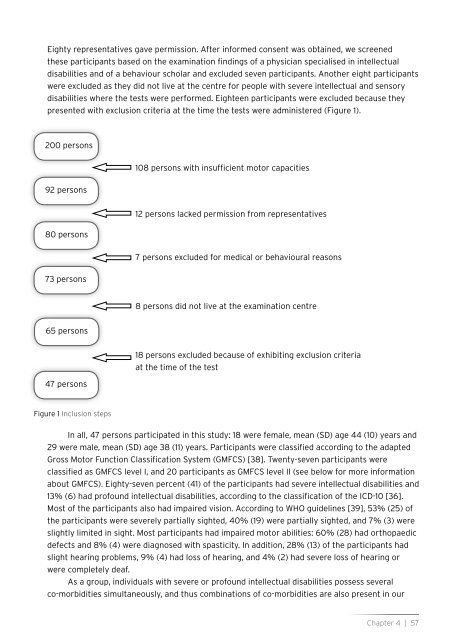Measuring physical fitness in Persons with Severe/Profound ...
Measuring physical fitness in Persons with Severe/Profound ...
Measuring physical fitness in Persons with Severe/Profound ...
- No tags were found...
Create successful ePaper yourself
Turn your PDF publications into a flip-book with our unique Google optimized e-Paper software.
Eighty representatives gave permission. After <strong>in</strong>formed consent was obta<strong>in</strong>ed, we screenedthese participants based on the exam<strong>in</strong>ation f<strong>in</strong>d<strong>in</strong>gs of a physician specialised <strong>in</strong> <strong>in</strong>tellectualdisabilities and of a behaviour scholar and excluded seven participants. Another eight participantswere excluded as they did not live at the centre for people <strong>with</strong> severe <strong>in</strong>tellectual and sensorydisabilities where the tests were performed. Eighteen participants were excluded because theypresented <strong>with</strong> exclusion criteria at the time the tests were adm<strong>in</strong>istered (Figure 1).200 persons92 persons108 persons <strong>with</strong> <strong>in</strong>sufficient motor capacities12 persons lacked permission from representatives80 persons7 persons excluded for medical or behavioural reasons73 persons8 persons did not live at the exam<strong>in</strong>ation centre65 persons47 persons18 persons excluded because of exhibit<strong>in</strong>g exclusion criteriaat the time of the testFigure 1 Inclusion stepsIn all, 47 persons participated <strong>in</strong> this study: 18 were female, mean (SD) age 44 (10) years and29 were male, mean (SD) age 38 (11) years. Participants were classified accord<strong>in</strong>g to the adaptedGross Motor Function Classification System (GMFCS) [38]. Twenty-seven participants wereclassified as GMFCS level I, and 20 participants as GMFCS level II (see below for more <strong>in</strong>formationabout GMFCS). Eighty-seven percent (41) of the participants had severe <strong>in</strong>tellectual disabilities and13% (6) had profound <strong>in</strong>tellectual disabilities, accord<strong>in</strong>g to the classification of the ICD-10 [36].Most of the participants also had impaired vision. Accord<strong>in</strong>g to WHO guidel<strong>in</strong>es [39], 53% (25) ofthe participants were severely partially sighted, 40% (19) were partially sighted, and 7% (3) wereslightly limited <strong>in</strong> sight. Most participants had impaired motor abilities: 60% (28) had orthopaedicdefects and 8% (4) were diagnosed <strong>with</strong> spasticity. In addition, 28% (13) of the participants hadslight hear<strong>in</strong>g problems, 9% (4) had loss of hear<strong>in</strong>g, and 4% (2) had severe loss of hear<strong>in</strong>g orwere completely deaf.As a group, <strong>in</strong>dividuals <strong>with</strong> severe or profound <strong>in</strong>tellectual disabilities possess severalco-morbidities simultaneously, and thus comb<strong>in</strong>ations of co-morbidities are also present <strong>in</strong> ourChapter 4 | 57











